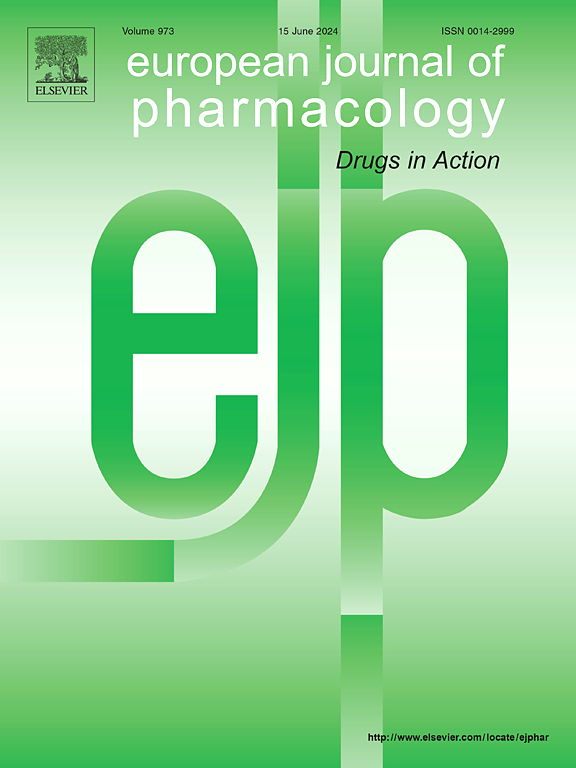甘草酸通过双重调节AMPK激活和MDM2抑制来稳定ACE2,从而减轻肝细胞脂肪变性和炎症
IF 4.7
3区 医学
Q1 PHARMACOLOGY & PHARMACY
引用次数: 0
摘要
甘草酸(glycyrrhizic acid, GA)作为一种从甘草属植物中提取的保肝植物化学物质,对代谢性肝脂肪变性和炎症具有独特的双靶点治疗效果。基于我们之前的发现,GA介导的小鼠脂肪性肝炎的改善与肝脏ACE2/Ang (1-7)/Mas轴信号的恢复密切相关,本研究旨在确定体外和体内肝细胞ACE2的作用,并从机制上解读GA如何重编程ACE2信号。我们发现GA治疗减轻了脂多糖/游离脂肪酸刺激的肝细胞的脂肪变性和炎症。GA逆转了ACE2和Mas蛋白表达的下调,同时抑制了Ang II和固醇调节元件结合蛋白1c蛋白的过表达。值得注意的是,ACE2基因沉默消除了有益的效果。此外,GA不仅逆转了ACE2 Y781的下调和磷酸化的AMPKα蛋白水平,而且还抑制了LPS/ d-半乳糖胺诱导的脂肪性肝炎小鼠肝脏和LPS/游离脂肪酸刺激的肝细胞中总MDM2蛋白和磷酸化MDM2蛋白的过表达。ga诱导的肝细胞中ACE2蛋白表达下调的恢复被AMPKα基因沉默或MDM2过表达所消除。因此,本研究首先确定GA是一种通过ace2依赖途径改善肝细胞脂肪变性和炎症的药物。此外,我们的研究结果表明,GA通过靶向AMPK和MDM2调控ACE2。我们认为GA通过ampk介导的磷酸化和mdm2介导的泛素化来稳定ACE2。我们的发现为GA保护肝脏作用的分子机制提供了新的见解。本文章由计算机程序翻译,如有差异,请以英文原文为准。

Glycyrrhizic acid mitigates hepatocyte steatosis and inflammation through ACE2 stabilization via dual modulation of AMPK activation and MDM2 inhibition
As a hepatoprotective phytochemical derived from Glycyrrhiza species, glycyrrhizic acid (GA) exhibits unique dual-target therapeutic efficacy against metabolic-driven hepatic steatosis and inflammation. Building upon our previous finding that GA-mediated amelioration of murine steatohepatitis is closely associated with restoration of hepatic ACE2/Ang (1–7)/Mas axis signaling, this study was designed to identify the role of hepatocyte ACE2 both in vitro and in vivo, and mechanistically decipher how GA reprograms ACE2 signaling. We found that GA treatment mitigated steatosis and inflammation in LPS/free fatty acid-stimulated hepatocytes. GA reversed the downregulation of ACE2 and Mas protein expression, while it suppressed the overexpression of Ang II and sterol regulatory element-binding protein 1c proteins. Notably, the ACE2 gene silencing abolished the beneficial effects. Furthermore, GA not only reversed the downregulation of ACE2 Y781 and phosphorylated AMPKα protein levels, but also inhibited the overexpression of total and phosphorylated MDM2 proteins in both the livers of LPS/D-galactosamine-induced steatohepatitic mice and in LPS/free fatty acid-stimulated hepatocytes. The GA-induced recovery of downregulated ACE2 protein expression in hepatocytes was abolished by either the AMPKα gene silencing or MDM2 overexpression. Therefore, this study first identifies GA as an agent that ameliorates hepatocyte steatosis and inflammation through the ACE2-dependent pathway. Further, our results demonstrate that GA regulates ACE2 by targeting AMPK and MDM2. We propose that GA stabilizes ACE2 via both AMPK-mediated phosphorylation and MDM2-mediated ubiquitination. Our findings offer new insights into the molecular mechanisms underlying the hepatoprotective effects of GA.
求助全文
通过发布文献求助,成功后即可免费获取论文全文。
去求助
来源期刊
CiteScore
9.00
自引率
0.00%
发文量
572
审稿时长
34 days
期刊介绍:
The European Journal of Pharmacology publishes research papers covering all aspects of experimental pharmacology with focus on the mechanism of action of structurally identified compounds affecting biological systems.
The scope includes:
Behavioural pharmacology
Neuropharmacology and analgesia
Cardiovascular pharmacology
Pulmonary, gastrointestinal and urogenital pharmacology
Endocrine pharmacology
Immunopharmacology and inflammation
Molecular and cellular pharmacology
Regenerative pharmacology
Biologicals and biotherapeutics
Translational pharmacology
Nutriceutical pharmacology.

 求助内容:
求助内容: 应助结果提醒方式:
应助结果提醒方式:


